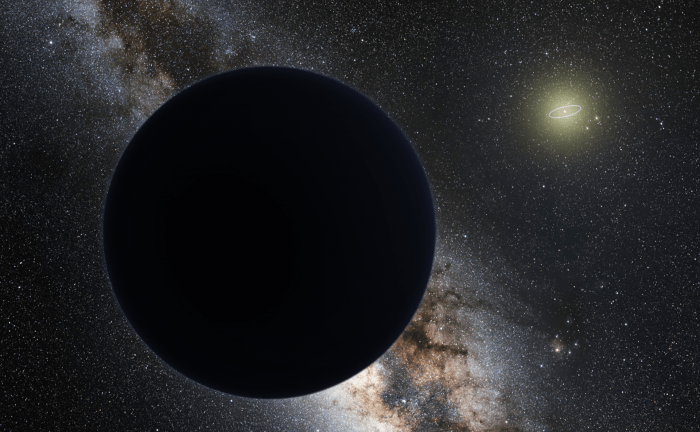In January of 2016, astronomers Mike Brown and Konstantin Batygin published the first evidence that there might be another planet in our Solar System. Known as "Planet 9", this hypothetical body was estimated to be about 10 times as massive as Earth and to orbit that our Sun at an average distance of 700 AU. Since that time, multiple studies have been produced that either support or cast doubt on the existence of Planet 9.
While some argue that the orbits of certain Trans-Neptunian Objects (TNOs) are proof of Planet 9, others argue that these studies suffer from an observational bias. The latest study, which comes from a pair of astronomers from the Complutense University of Madrid (UCM), offers a fresh perspective that could settle the debate.

Using a new technique that focuses on extreme TNOs (ETNOs), they believe the case for Planet 9 can be made. Extreme Trans-Neptunian Objects are those that orbit our Sun at average distances greater than 150 AU, and therefore never cross Neptune's orbit. As the UMC team indicate in their study, which was recently published in the Monthly Notices of the Royal Astronomical Society, the distances between the ETNOs nodes and the Sun may point the way towards Planet 9.
These nodes are the two points at which the orbit of a celestial body crosses the plane of the Solar System. It is at these points that the chances of interacting with other bodies in the Solar System is the greatest, and hence where ETNOs are most likely to experience a drastic change in their orbits (or a collision).
By measuring where these nodes are, the team believed they could tell if the ETNOs are being perturbed by another object in the area. As Carlos de la Fuente Marcos, one of the authors on the study, explained in an interview with The Information and Scientific News Service (SINC):
"If there is nothing to perturb them, the nodes of these extreme trans-Neptunian objects should be uniformly distributed, as there is nothing for them to avoid, but if there are one or more perturbers, two situations may arise.
One possibility is that the ETNOs are stable, and in this case they would tend to have their nodes away from the path of possible perturbers, he adds, but if they are unstable they would behave as the comets that interact with Jupiter do, that is tending to have one of the nodes close to the orbit of the hypothetical perturber".
For the sake of their research, Doctors Carlos and Raul de la Fuente Marcos conducted calculations and data mining to analyse the nodes of 28 ETNOs and 24 extreme Centaurs (which also orbit the Sun at average distances of more than 150 AUs). What they noticed was that these two populations became clustered at certain distances from the Sun, and also noted a correlation between the positions of the nodes and the inclination of the objects.
This latter find was especially unexpected, and led them to conclude that the orbits of these populations were being affected by the presence of another body – much in the same way that the orbits of comets within our Solar System have been found to be affected by the way they interact with Jupiter.
As De la Fuente Marcos emphasised:
"Assuming that the ETNOs are dynamically similar to the comets that interact with Jupiter, we interpret these results as signs of the presence of a planet that is actively interacting with them in a range of distances from 300 to 400 AU.
We believe that what we are seeing here cannot be attributed to the presence of observational bias".
As already mentioned, previous studies that have challenged the existence of Planet 9 cited how the study of TNOs have suffered from an observational bias. Basically, they have claimed that these studies made systematic errors in how they calculated the orientations in the orbits of TNOs, in large part because they had all been directed towards the same region of the sky.
By looking at the nodal distances of ETNOs, which depend on the size and shape of their orbits, this most recent study offers the first evidence of Planet 9's existence that is relatively free of this bias. At the moment, only 28 ETNOs are known, but the authors are confident that the discovery of more – and the analysis of their nodes – will confirm their observations and place further constraints on the orbit of Planet 9.
In addition, the pair of astronomers offered some thoughts on recent work that has suggested the possible existence of a Planet 10. While their study does not take into account the existence of a Mars-sized body – which is said to be responsible for an observable "warp" in the Kuiper Belt – they acknowledge that there is compelling evidence that such a planet-sized body exists.
As de la Fuente Marcos said:
"Given the current definition of planet, this other mysterious object may not be a true planet, even if it has a size similar to that of the Earth, as it could be surrounded by huge asteroids or dwarf planets.
In any case, we are convinced that Volk and Malhotra's work has found solid evidence of the presence of a massive body beyond the so-called Kuiper Cliff, the furthest point of the trans-Neptunian belt, at some 50 AU from the Sun, and we hope to be able to present soon a new work which also supports its existence".
It seems that the outer Solar System is getting more crowded with every passing year. And these planets, if and when they are confirmed, are likely to trigger another debate about which Solar bodies are rightly designated as planets and which ones aren't. If you thought the "planetary debate" was controversial and divisive before, I recommend staying away from astronomy forums in the coming years!
